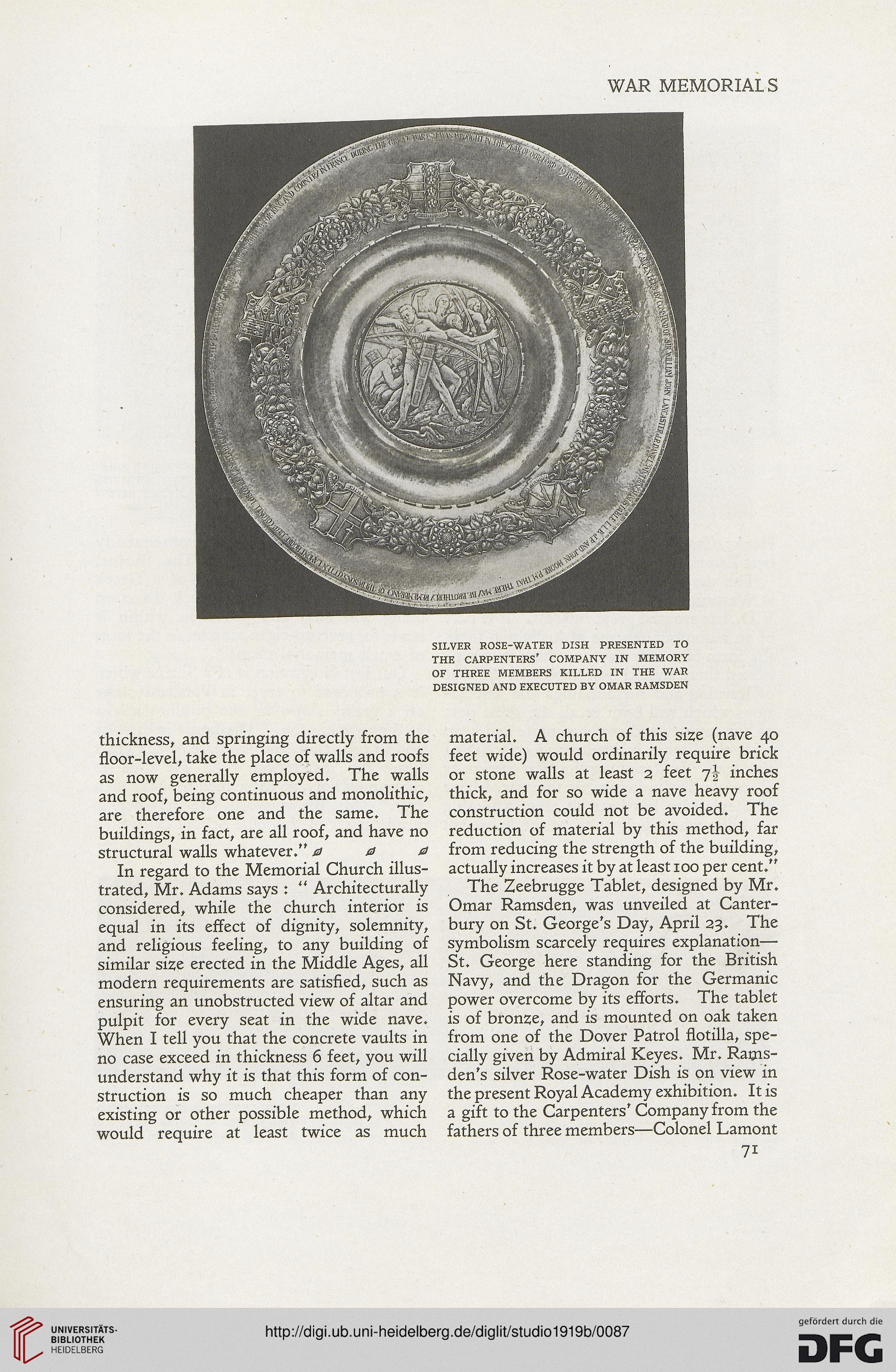WAR MEMORIALS
SILVER ROSE-WATER DISH PRESENTED TO
THE CARPENTERS’ COMPANY IN MEMORY
OF THREE MEMBERS KILLED IN THE WAR
DESIGNED AND EXECUTED BY OMAR RAMSDEN
thickness, and springing directly from the
floor-level, take the place of walls and roofs
as now generally employed. The walls
and roof, being continuous and monolithic,
are therefore one and the same. The
buildings, in fact, are all roof, and have no
structural walls whatever.” a a a
In regard to the Memorial Church illus-
trated, Mr. Adams says : “ Architecturally
considered, while the church interior is
equal in its effect of dignity, solemnity,
and religious feeling, to any building of
similar size erected in the Middle Ages, all
modern requirements are satisfied, such as
ensuring an unobstructed view of altar and
pulpit for every seat in the wide nave.
When I tell you that the concrete vaults in
no case exceed in thickness 6 feet, you will
understand why it is that this form of con-
struction is so much cheaper than any
existing or other possible method, which
would require at least twice as much
material. A church of this size (nave 40
feet wide) would ordinarily require brick
or stone walls at least 2 feet Jj inches
thick, and for so wide a nave heavy roof
construction could not be avoided. The
reduction of material by this method, far
from reducing the strength of the building,
actually increases it by at least 100 per cent.”
The Zeebrugge Tablet, designed by Mr.
Omar Ramsden, was unveiled at Canter-
bury on St. George’s Day, April 23. The
symbolism scarcely requires explanation—
St, George here standing for the British
Navy, and the Dragon for the Germanic
power overcome by its efforts. The tablet
is of bronze, and is mounted on oak taken
from one of the Dover Patrol flotilla, spe-
cially given by Admiral Keyes. Mr. Rams-
den’s silver Rose-water Dish is on view in
the present Royal Academy exhibition. It is
a gift to the Carpenters’ Company from the
fathers of three members—Colonel Lamont
7i
SILVER ROSE-WATER DISH PRESENTED TO
THE CARPENTERS’ COMPANY IN MEMORY
OF THREE MEMBERS KILLED IN THE WAR
DESIGNED AND EXECUTED BY OMAR RAMSDEN
thickness, and springing directly from the
floor-level, take the place of walls and roofs
as now generally employed. The walls
and roof, being continuous and monolithic,
are therefore one and the same. The
buildings, in fact, are all roof, and have no
structural walls whatever.” a a a
In regard to the Memorial Church illus-
trated, Mr. Adams says : “ Architecturally
considered, while the church interior is
equal in its effect of dignity, solemnity,
and religious feeling, to any building of
similar size erected in the Middle Ages, all
modern requirements are satisfied, such as
ensuring an unobstructed view of altar and
pulpit for every seat in the wide nave.
When I tell you that the concrete vaults in
no case exceed in thickness 6 feet, you will
understand why it is that this form of con-
struction is so much cheaper than any
existing or other possible method, which
would require at least twice as much
material. A church of this size (nave 40
feet wide) would ordinarily require brick
or stone walls at least 2 feet Jj inches
thick, and for so wide a nave heavy roof
construction could not be avoided. The
reduction of material by this method, far
from reducing the strength of the building,
actually increases it by at least 100 per cent.”
The Zeebrugge Tablet, designed by Mr.
Omar Ramsden, was unveiled at Canter-
bury on St. George’s Day, April 23. The
symbolism scarcely requires explanation—
St, George here standing for the British
Navy, and the Dragon for the Germanic
power overcome by its efforts. The tablet
is of bronze, and is mounted on oak taken
from one of the Dover Patrol flotilla, spe-
cially given by Admiral Keyes. Mr. Rams-
den’s silver Rose-water Dish is on view in
the present Royal Academy exhibition. It is
a gift to the Carpenters’ Company from the
fathers of three members—Colonel Lamont
7i




